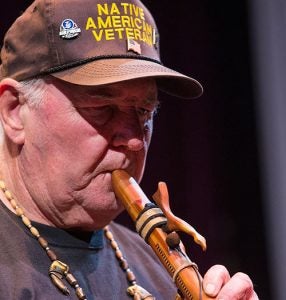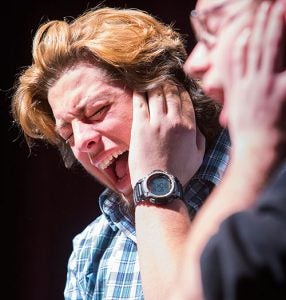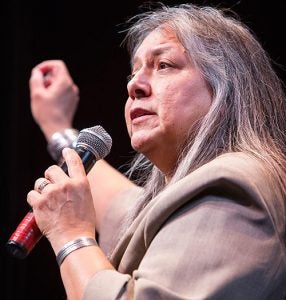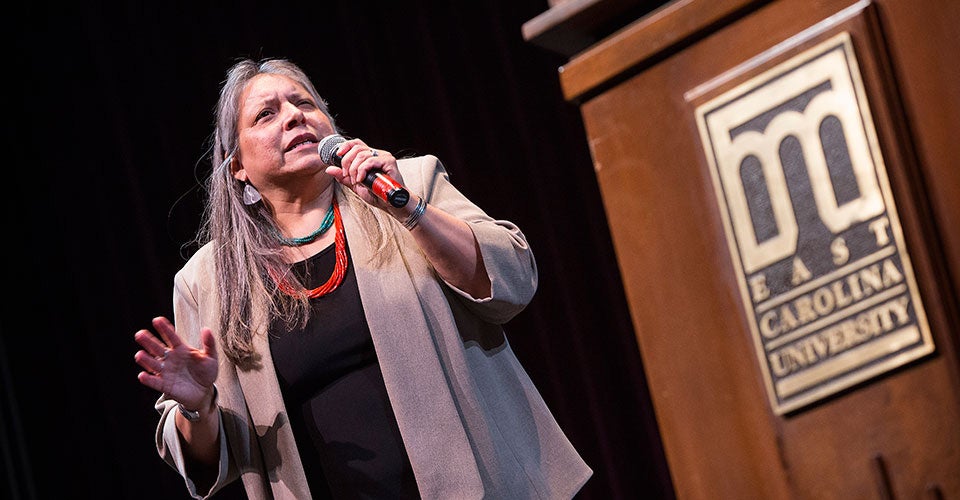CODE TALKERS OF WWII
How the original 29 Navajo Code Talkers made history
A five-man drum circle welcomed more than 600 audience members to East Carolina University’s Wright Auditorium at last night’s final 2015-16 Voyages of Discovery lecture. Zonnie Gorman, acclaimed historian of the WWII Navajo Code Talkers, discussed the history of the Code Talkers, her family’s connection, how the code was developed and how 29 men made history.

Jim Cooper performs Native American music before the lecture.
“Zonnie Gorman’s talk brought to life a critical contribution of the Navajo people to America’s victory in the Pacific during World War II,” said William Downs, dean of the Thomas Harriot College of Arts and Sciences. “It also underscored for those in the audience the many – sometimes painful – ironies of a people once discouraged by the government from speaking their native language, who then became indispensable to that same government precisely because of their language. History is full of such contradictions, and Gorman’s lecture provided a unique glimpse of that important time in our shared history.”
Gorman welcomed the audience in her native tongue and explained in English that it is important to know who you are; your family connections. In 1989, Gorman embarked on a personal journey that led to the discovery that her father, the late Dr. Carl Gorman, was a member of the pilot group of Navajo men who devised the code that the U.S. Marine Corps would use to thwart the Japanese during WWII; one of the original “First 29” Navajo Code Talkers.
According to Gorman, the history of the code began shortly after the Dec. 7, 1941 bombing of Pearl Harbor, which catapulted the United States into declaring war.
Immediately there was a need to build up the military, troops, equipment and communications. The Japanese had already broken the U.S. military codes and the U.S. Marine Corps was concerned.
Philip Johnston is credited for suggesting the idea of using the Navajo language to devise a new communications code. Johnston had learned to speak some Navajo as a young boy. His parents, who were Protestant missionaries, had moved to Arizona in 1897 when Johnston was only 4 years old, which gave Johnston the opportunity to grow up on a Navajo reservation and learn the language.
Early in 1942, the Marine Corps learned about Johnston’s idea. Using Native American languages as code for the Army was not a new idea; the U.S. Army had used approximately 22 different tribes for various reasons throughout WWI and WWII. However, this was the U.S. Marine Corps first attempt at using a native language as code, and the first time that the Navajo people had ever been consulted.
In February 1942, after a brief test of sample English messages were coded, transmitted and transcribed back into English by a group of four Navajo men, Gorman said it was recommended that 200 Navajo men be recruited. At the time, the commandant in Washington, D.C. was reserved about the idea and approved the recruitment of 30 men.
During a period of two weeks in April 1942, men from the Navajo reservation in Phoenix, Ariz. were recruited and later become known as the First 29 – the 30th man, Gorman later discovered, had not continued with the group and later joined the U.S. Army. The First 29 were sworn in for training on May 4, 1942 in Gallup, N.M., where the men devised a code of approximately 200 terms.
According to Gorman’s research, the code consisted of code words, substitution words and a devised alphabet. For code words, America became “Our Mother,” Germany became “Iron Hat” and Spain became “Sheep Pain.”

ECU student Jackson Lamm sings and plays the drum before the lecture.
Substitution words were used for groups of items. For example, airplanes were referred to as birds, since they flew, and then were translated into the Navajo word for that type of bird. So an observation plane would be referred to as an owl, which became Ne-as-jah in Navajo, a bomber would be referred to as a buzzard, which became Jay-she, and a fighter would be a hummingbird, which became Da-he-tih-hi.
When devising the new alphabet, the letter A became ant, or Wol-ia-choe in Navajo. B became bear, or Sh-ush. C became cat, or Moasi. Later, more words were added to represent the alphabet so that three words represented each letter, making the code more complicated to break.
Gorman said, “The code was not just a translation of words into Navajo.” She said even Navajo people who heard the code would have thought it “sounded like gibberish,” which is why it was so effective.
Of the original 29 Navajo Code Talkers, 27 were sent overseas into active duty in the 1st and 2nd Marine Divisions. The two men who stayed stateside trained the new recruits. Throughout the war, a total of 400 Navajo Code Talkers were trained and served in the Pacific. Only 11 were killed in action, and of the original 27 who went overseas, 26 returned, including Gorman’s father.

Zonnie Gorman speaks about her father’s experiences as a Navajo Code Talker during World War II.
In 1968, Gorman said the Navajo code was declassified and the men began to be honored for their contributions to the war effort. In 1975, the First 29 participated in the Tournament of Roses Parade. In 1980 they appeared on the television show “Real People.” In 1982, National Navajo Code Talkers Day was established.
“I’m very proud of those men, my father and my family,” said Gorman.

Zonnie Gorman speaks about her father’s experiences as a Navajo Code Talker during World War II.